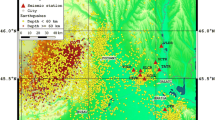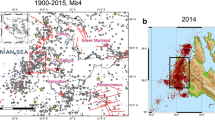Abstract
Site characterization was carried out for Muscat region using the ambient noise measurements applying the horizontal-to-vertical spectral ratio (HVSR) technique and using active seismic survey utilizing the multichannel analysis of surface waves (MASW) of survey data. Microtremors measurements were carried out at 459 sites using short-period sensors. This extensive survey allowed the fundamental resonance frequency of the soft soil to be mapped and areas prone to site amplification to be identified. The results indicate a progressive decrease in the fundamental resonance frequencies from the southern and eastern parts, where the bedrock outcrops, toward the northern coast where a thickness of sedimentary cover is present. Shear wave velocity (Vs) was evaluated using the 2-D MASW at carefully selected 99 representative sites in Muscat. These 99 sites were investigated with survey lines of 52 m length. 1-D and interpolated 2-D profiles were generated up to a depth range 20–40 m. The vertical Vs soundings were used in the SHAKE91 software in combination with suitable seismic input strong motion records to obtain the soil effect. Most of the study area has amplification values less than 2.0 for all the considered spectral periods. The estimated fundamental frequencies obtained using the H/V spectral ratio method and using SHAKE91 are found to be in a relatively good agreement. Maps of spectral amplification, earthquake characteristics on the ground surface for peak ground and spectral accelerations at 0.1, 0.2, 0.3, 1.0, and 2.0 s, for 475 years return period are produced. The surface ground motion maps show that the hazard level is moderate with expected PGA in the range 0.059–0.145 g for 475 years return period.






























Similar content being viewed by others

References
Aki K, Richards PG (1980) Quantitative seismology. Freeman and Co., New York
Al Atik L, Abrahamson NA (2010) An improved method for non-stationary spectral matching. Earthq Spectra 26:601–617
Ambraseys NN, Melville CP, Adams RD (1994) The seismicity of Egypt, Arabia and Red Sea. Cambridge University Press, Cambridge
Anbazhagan P, Sitharam T (2008) Site characterization and site response studies using shear wave velocity. J Seismol Earthq Eng 10:53–67
Bindi D, Parolai S, Spallarossa D, Cattaneo M (2000) Site effects by H/V ratio: comparison of two different procedures. J Earthq Eng 4:97–113
Boore D (2008) Notes on smoothing over intervals that are constant over logarithmically-spaced frequencies. http://daveboore.com/daves_notes/notes%20on%20smoothing%20over%20logarithmically%20spaced%20freqs.pdf
Borcherdt RD (1970) Effects of local geology on ground motion near San Francisco Bay. Bull Seism Soc Am 60:29–61
BRGM/MPM (1986) Geological maps 1:100,000 scale, sheets Seeb and Muscat
Bullen KE (1963) An Introduction to the theory of seismology, 3rd edn. Cambridge University press, Cambridge
Cramer CH, Gomberg JS, Schweig ES, Waldron BA, Tucker K (2004) The Memphis, Shelby County, Tennessee, seismic hazard maps. U.S. Geological Survey Open-File Report 04-1294
Cramer CH, Gomberg JS, Schweig ES, Waldron BA, Tucker K (2006) First USGS urban seismic hazard maps predict the effects of soils. Seismol Res Lett 77:23–29
Dunand F, Bard PY, Chatelin JL, Guéguen Ph, Vassail T, Farsi MN (2002) Damping and frequency from random method applied to in situ measurements of ambient vibrations: evidence for effective soil structure interaction. 12th European conference on earthquake engineering, London. Paper# 869
El-Hussain I, Deif A, Al-Jabri K, Toksoz N, El-Hady S, Al-Hashmi S, Al-Toubi K, Al-Shijby Y, Al-Saify M, Kuleli S (2012a) Probabilistic seismic hazard maps for the Sultanate of Oman. Nat Hazard 64:173–210. doi:10.1007/s11069-012-0232-3
El-Hussain I, Deif A, Al-Jabri K, Al-Hashmi S, Al-Toubi K, Al-Shijby Y, Al-Saify M, Al-Habsi Z (2012b) Mitigation of seismic risk by microzonation Muscat Area, Sultanate of Oman, (Phase II). Project #22409017, submitted to Sultan Qaboos University, Oman
Idriss IM, Sun JI (1992) User’s manual for SHAKE91, COMPUTER program for conducting equivalent linear seismic response analyses of horizontally layered soil deposits. University of California, Davis
Kanli A, Tildy P, Pronay Z, Pinar A, Hermann L (2006) VS30 mapping and soil classification for seismic site effect evaluation in Dinar region, SW Turkey. Geophys J Int 165:223–235
Konno K, Ohmachi T (1998) Ground motion characteristics estimated from spectral ratio between horizontal and vertical components of microtremor. Bull Seismol Soc Am 88:228–241
Kramer SL (1995) Geotechnical earthquake engineering. Prentice Hall, Inc., Upper Saddle River
Kramer SL (1996) Geotechnical earthquake engineering. Published by Pearson Education Ptd. Ltd, Reprinted 2003, Delhi, India
Lachet C, Bard PY (1994) Numerical and theoretical investigations on the possibilities and limitations of the Nakamura’s technique. J Phys Earth 42:377–397
Lachet C, Bard PY (1995) Theoretical investigation of the Nakamura’s technique. In: Proceedings of the 3rd international conference on recent advances in geotechnical earthquake engineering and soil dynamics, vol 2, pp 617–675
Lermo J, Chavez-Garcia FJ (1994) Are microtremors useful in site response evaluations? Bull Seismol Soc Am 84:1350–1364
Mahajan SS, Ranjan R, Sporry R, Champatiray PK, Westen CJV (2007) Seismic microzonation of Dehradun City using geophysical and geotechnical characteristics in the upper 30 m of soil column. J Seismol 11:355–370
Malagnini L, Tricarico P, Rovelli A, Hermann RB, Opics S, Biella G, de Franco R (1996) Explosion, earthquake and ambient noise recording in a Pliocene sediments-filled valley: inferences on seismic response properties by reference- and non-reference site techniques. Bull Seismol Soc Am 86:670–682
Miller RD, Xia J, Park CB, Ivanov J (1999) Multichannel analysis of surface waves to map bedrock. Lead Edge 18:1392–1396
Mohamed AME, Deif A, El-Hadidy S, Moustafa Sayed SR, El Werr A (2008) Definition of soil characteristics and ground response at the northwestern part of the Gulf of Suez, Egypt. J Geophys Eng 5:420–437
Nakamura Y (1989) A method for dynamic characteristics estimation of subsurface using microtremor of the ground surface. QR of RTRI, 30, No. 1, 89, Feb
Nakamura Y (1996) Real-time information systems for hazards mitigation. In: Proceedings of the 11th world conference on earthquake engineering, Acapulco, Mexico
NEHRP (2001) NEHRP recommended provisions for seismic regulations for new buildings and other structures (FEMA 368 and 369). 2000 ed. Building Seismic Safety Council, National Institute of Building Sciences, Washington, DC
Nogoshi M, Igarashi T (1970) On the propagation characteristics of microtremors. J Seismol Soc Jpn 23:264–280 (in Japanese with English abstract)
Nogoshi M, Igarashi T (1971) On the amplitude characteristics of microtremor (part 2). J Seism Soc Jpn 24:26–40 (in Japanese with English abstract)
Ohori M, Nobata A, Wakamatsu K (2002) A comparison of ESAC and FK methods of estimating phase velocity using arbitrarily shaped microtremor analysis. Bull Seismol Soc Am 92:2323–2332
Park CB, Miller RD, Xia J (1999) Multi-channel analysis of surface waves. Geophysics 64:800–808
Parolai S, Bindi D, Baumbach M, Grosser H, Milkereit C, Karakisa S, Zunbul S (2004) Comparison of different site response estimation techniques using aftershocks of the 1999 Izmit earthquake. Bull Seismol Soc Am 94:1096–1108
Picozzi M, Parolai S, Albarello D (2005) Statistical analysis of noise horizontal to vertical spectral ratios (HVSR). Bull Seismol Soc Am 95. doi:10.1785/0120040152
Safak E (1997) Models and methods to characterize site amplification from a pair of records. Earthq Spectra 13:97–129
Schnabel PB, Lysmer J, Seed HB (1972) SHAKE: a computer program for earthquake response analysis of horizontally layered sites, report no. UCB/EERC-72/12. Earthquake Engineering Research Center, University of California, Berkeley
Seed HB, Idriss IM (1970) Soil moduli and damping factors for dynamic response analyses. Earthquake Engineering Research Center, University of California, Berkeley, California, Rep. No. EERC-70/10
Seed HB, Wong RT, Idriss IM, Tokimatsu K (1986) Moduli and damping factors for dynamic analyses of cohesionless soils. J Geotech Eng 112:1016–1032
SeisRefa (1991) Refraction analysis program, version 1.30, USA. Copyright, Oyo Corporation
SESAME (2004) Site effects assessment using ambient excitations European research project. http://sesamefp5.obs.ujf-grenoble.fr
Seshunarayana T, Sundararajan N (2004) Multichannel analysis of surface waves (MASW) for mapping shallow subsurface layers—a case study, Jabalpur, India. 5th International Conference on Petroleum Geophysics, Hyderabad, India, pp 642–646
Seshunarayana T, Prabhakara Prasad P, Prasada Rao SVV, Kousalya M (2003) Seismic survey for determination of Vp and Vs of shallow subsoil & bedrock depth in Jabalpur area. Tech report No. NGRI-2003-Exp-384
Stokoe II KH, Wright GW, James AB, Jose MR (1994) Characterization of geotechnical sites by SASW method. In: Woods RD (ed) Geophysical characterization of sites: ISSMFE Technical Committee #10, Oxford Publishers, New Delhi
Street R, Woolery E, Wang Z, Harik IE (1997) Soil classifications for estimating site-dependent response spectra and seismic coefficients for building code provisions in western Kentucky. Eng Geol 46:331–347
Street R, Wooley EW, Wang Z, Harris JB (2001) NEHRP soil classification for estimating site dependant seismic coefficients in the Upper Mississippi Embayment. Eng Geol 62:123–135
Sundararajan N, Seshunarayana T (2011) Liquefaction hazard assessment of earthquake prone area: a case study based on shear wave velocity by multichannel analysis of surface waves (MASW). Geotech Geol Eng 29:267–275
Surve G, Mohan G (2010) Site response studies in Mumbai using (H/V) Nakamura technique. Nat Hazards 54:783–795
Theodulidis N, Bard PY (1995) Horizontal to vertical spectral ratio and geological conditions, an analysis of strong motion data from Greece and Taiwan (SMART-1). Soil Dyn Earthq Eng 14:177–197
Tian G, Steeples DW, Xia J, Miller RD (2003) Multichannel analysis of surface wave method with the auto juggie. Soil Dyn Earthq Eng 23:243–247
Tokimatsu K, Tamura S, Kojima H (1992) Effects of multiple modes on Rayleigh wave dispersion characteristics. J Geotech Eng 118:1529–1543
Xia J, Miller RD, Park CB (1999) Estimation of near-surface shear-wave velocity by inversion of Rayleigh wave. Geophysics 64:691–700
Xia J, Miller RD, Park CB, Ivanov J (2000) Construction of 2-D vertical shear wave velocity field by the multichannel analysis of surface wave technique. In: Proceedings of the symposium on the application of geophysics to engineering and environmental problems, Arlington, 20–24 Feb 2000
Xia J, Miller RD, Park CB, Hunter JA, Harris JB, Ivanov J (2002) Comparing shear-wave velocity profiles inverted from multichannel surface wave with borehole measurements. Soil Dyn Earthq Eng 22:181–190
Zaslavsky Y, Shapira A, Gorstein M, Kalmanovich M, Giller V, Ion Livshits I, Alexander Shvartsburg A, Ataev G, Aksienko T, Dagmara Giller D, Ilana Dan I, Perelman N (2003) Local site effect of Hashefela and Hasharon regions based on ambient vibration measurements, Progress report, July, 2003, GII Report No. 569/313/03
Acknowledgments
The authors express their sincere appreciation to Oman Ministerial Cabinet for funding this project under project # 22409017. Thanks go also to Sultan Qaboos University for the strong support and encouragement and to the Seismic hazard committee members for their interest and assistance to complete this project.
Author information
Authors and Affiliations
Corresponding author
Rights and permissions
About this article
Cite this article
El-Hussain, I., Deif, A., Al-Jabri, K. et al. Seismic microzonation for Muscat region, Sultanate of Oman. Nat Hazards 69, 1919–1950 (2013). https://doi.org/10.1007/s11069-013-0785-9
Received:
Accepted:
Published:
Issue Date:
DOI: https://doi.org/10.1007/s11069-013-0785-9



